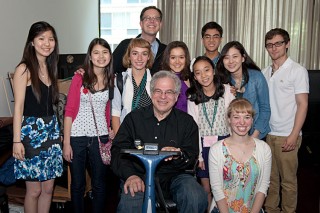Title

Alum and faculty member Itzhak Perlman (center) was on the faculty at the seventh Starling-Delay Symposium for Violin Studies.
(Photo by Nan Melville )The biennial Starling-DeLay Symposium on Violin Studies brings together 200 professional violin teachers and 10 exceptional student artists from around the world for a weeklong event focusing on the art of violin performance and pedagogy. The seventh Symposium, held in late May and early June, featured master classes, lectures, recitals, and, for the first time, a Q&A with the student artists. Moderated by Brian Lewis (B.M. ’91, M.M. ’93, violin), the symposium’s artistic director, the panel discussion showed how comfortable these students are on stage without their fiddles, speaking with eloquence, passion, and humor about how and why they do what they do best—play the violin,
Body
Lewis began by asking the young virtuosos what draws them to performing. “I love the goose bumps you get,” answered 16-year-old Pre-College student Angela Wee. “I love how emotional music can be. It really satisfies me.”
Pre-College student Elli Choi, 11, said she finds a lot of motivation in the audience. “When people clap, I always feel reborn in that second, and it encourages me to practice more and become better.”
While Robyn Bollinger, 24, started off wanting to be a musician “because I wanted to wear a long black dress, like my mother [a professional violist],” as an adult, she draws inspiration from more serious matters. A student at the New England Conservatory, she talked about how music helped those affected by the Boston Marathon bombings in April. “There were orchestras playing at the finish line, and groups [including friends of hers] traveled to hospitals to perform for the injured. What an honor it is to express things for others that they can’t necessarily express for themselves.” Being a musician, she added, is “a great responsibility and a great honor.”
The panel discussion had been suggested by past participants, one of whom reported in a post-panel survey that “seeing the student artists perform in master classes and recitals only provides one angle of who these kids are. Hearing them talk about what they do, and why, ultimately helps us learn what motivates young players. It’s all part of learning how to teach effectively.”
Teaching effectively is just one of the enduring themes of the symposium, Lewis said. “The goal was always to create a positive and supportive environment, one in which a young artist would feel as comfortable as possible in an intense working environment,” he noted, adding that Dorothy DeLay (Fellowship ’42, violin), the longtime faculty member and the inspiration for the symposium, had a “passion for increasing the potential of each student.”
That vision continues to resonate with all the symposium participants. Third-year violinist William Shaub told the audience that he has “a responsibility to respect and defend our tradition, as classical musicians, and to preserve it for future generations.” He added that the dedication and focus required every day of a musician keep things in perspective and show a way “to become an artist as a citizen.”
Through all of the questions and answers, from the serious to the silly, no one stated the underlying theme of the symposium more simply than 15-year-old Eric Tsai of Alabama. Met with great applause from a packed Paul Hall, he said “I don’t think I like doing anything else as much as I like playing the violin.”




